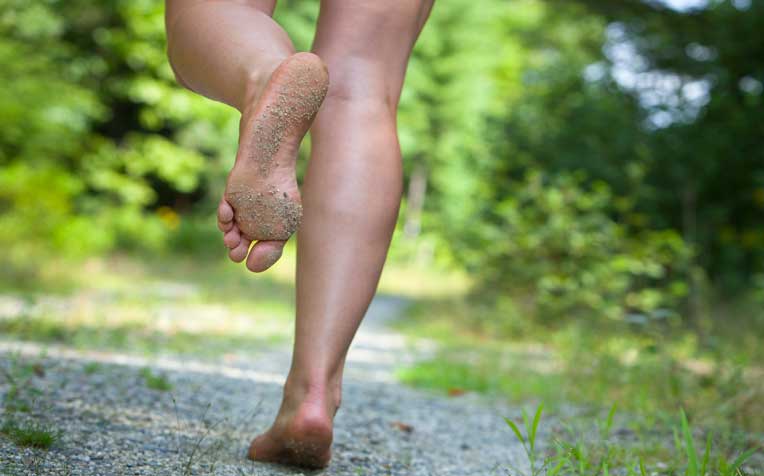
Barefoot running amateurs should begin with a relatively safe terrain first.
Minimalist footwear has been on the market for the last 15-20 years. It is not a new genre of footwear. For example, racing shoes used in a running race or for speed/interval training could be considered as part of the category and used to be called racing flats. These shoes generally have a thin midsole and low toe drop. However in recent times, they have been renamed as minimalist footwear.
Minimalist footwear serves as a good transition for a runner who wishes to switch from shoe running to barefoot running. It will require a period of time for your body to adapt to this style of running.
If you are considering barefoot/minimalist running, it is helpful to be aware of the possible detrimental effects. It has been documented that barefoot/minimalist running promotes a more midfoot-to-forefoot strike. During a mid-forefoot strike, the ankle joint is placed in a pointed-down position during landing and this landing position increases the risk of foot conditions known as metatarsal stress fracture[1] and Achilles tendinosis[2].
As a general guideline, if you are considering getting into barefoot/minimalist running, it is good to take note of the following:
- You should have been running regularly for the past one year.
- Plan to transition from shoe running to barefoot running gradually. For instance, you could start by allocating 3-5 per cent of your total weekly running time/distance to barefoot/minimalist running.
- Do running drills to improve running form 1-2 times a week.
- Pick relatively safe terrain to run in, such as a beach or grassy field, as opposed to a rocky or rough terrain.
- Be attuned to the needs of your body. In the first few weeks there may be aches and pain, which should gradually reduce after a period of adaptation.
- Ask yourself why you want to start barefoot/minimalist running and be clear about its pros and cons.
- Start with minimalist footwear before going totally barefoot.
- You should avoid barefoot/minimalist running if you are overweight or have a high body mass index (BMI).
In conclusion, the majority of runners would find barefoot /minimalist running a useful adjunct training tool to supplement their weekly runs. Usually only a small percentage of runners are able to consistently adopt barefoot/minimalist running at a high volume without persistent injuries.
Key pointers for barefoot/minimalist running
In summary, keep in mind these key points:
- To only consider the foot strike of a runner and conclude that one given style reduces the incidence of injury and improves efficiency is premature. There are other factors, such as the position of your foot in regards to the centre of your body, joint mobility, muscle strength and muscle flexibility.
- The message that barefoot/minimalist running is more ‘natural’ and better for you is a generalised statement. Some of us will do well with minimalist or barefoot running. Others would be better off in running shoes.
- Use minimalist/barefoot running as a small part of your training programme.
- If you choose to experiment with it, the safer way is to run barefoot on a beach or on a soft, safe environment without shoes for 5-10 minutes and build upon that.
- You don’t always need minimalist shoes to start barefoot running, as the material to make a pair is usually is less than a traditional running shoes yet can cost more.
Key features to look out for when purchasing minimalist shoes
- Be aware there are subcategories in the minimalist range, mainly the toe drop (heel height differential). This is measured by subtracting the height of the midsole at the heel from the height at the forefoot. Consider body weight and midsole material too.
- 0-4mm is considered very minimalist. Usually for experienced minimalist runners. Termed barefoot footwear.
- 5-8mm is moderately minimalist. Good for beginners. Similar to ‘racing flats’.
- Ensure the shoes have laces or Velcro straps to allow a snug fit.
- Make sure you feel comfortable when wearing and running in it.
Advantages and disadvantages of barefoot/minimalist running
Pros:- Increased proprioception (sense of space and balance) due to the stimulation of many nerve endings on the sole of the feet.
- Strengthening of intrinsic foot muscle.
- Less weight on your feet, which technically translates to less energy demand per running stride.
- Wound or injuries on feet from limited protection in the urban surrounding.
- Increased strain on the Achilles tendon and midfoot/forefoot area, which may predispose you to stress related injuries.
[1] The metatarsal bones are the long bones in your foot that connect your ankle to your toes. A stress fracture is a break in the bone that happens with repeated injury or stress. Stress fractures are caused by using the foot in the same way over and over.
[2] Achilles tendinosis is an overuse injury of the Achilles tendon, the band of tissue that connects calf muscles at the back of the lower leg to your heel bone. Achilles tendinosis most commonly occurs in runners who have suddenly increased the intensity or duration of their runs.
Ref: S13
Contributed by


















 Get it on Google Play
Get it on Google Play